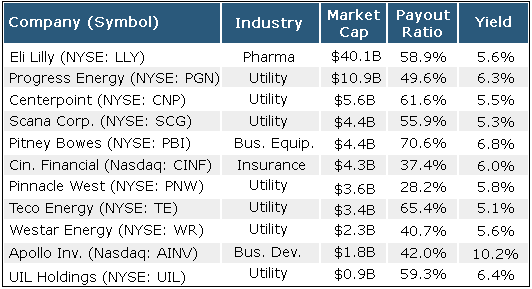They say success comes at a price. The same thing applies to capital gains.
Most investors forgot that lesson in the 1990s, when high-growth 'dot-com' stocks were all the rage. Growth at any price was the name of the game, and some investors paid dearly for it.
Why not get paid instead?
That's why dividends are so important. A company paying a stable, steady dividend is more likely to be a safe investment than your average growth stock. Dividends may have lost some of their luster in the go-go 1990s, but there is no denying their power. Standard & Poor's estimates that dividends have accounted for about 44% of the market's total return during the last 80 years.
There's something to be said for a steady dividend check rolling in through good times and bad. Even better, reinvesting dividends can build enormous wealth over time. For example, if you invested $10,000 in the S&P 500 in 1965 and held it to today, you'd be sitting on $110,600. Not bad, but consider this: if you had reinvested dividends, you'd have $451,300, or four times as much!
Reinvesting dividends is simpler than some might think. All you need is a DRIP, and you don't have to go through your broker to use one.
DRIPs are an incredibly easy way to compound returns over the long-run, but the process isn't as simple as picking a high-yielding stock with a DRIP. Investors will want to make sure their dividend is safe. After all, a hefty dividend paid by a company running low on cash won't last long. A good place to start is the dividend payout ratio, which measures the percentage of a company's earnings that are being paid out as dividends.
For example: say a company earns $100 million in a year and paid out $70 million in dividends. That makes for a payout ratio of 70%. A good payout ratio depends on the industry. A ratio above 100% in most industries means a company is paying out more than it's earning -- meaning it's dipping into cash reserves to meet the payment, and a dividend cut could come if the earnings picture doesn't improve.
By simply looking at the S&P's puny yield of 2.2%, it's tempting to think the era of high dividends is over. Not true. There are many options for yield-hungry investors to choose from. And after consulting the StreetAuthority research staff, we came up with the following criteria:
- Market capitalization of at least $250 million
- Currently yielding at least 5%
- Dividend payout ratio of less than 80%
- Offers a DRIP to investors
After sifting through the data, here's what turned up:

As a starting point, conservative investors may want to choose among the utilities on this list. Their highly regulated businesses provide for stable cash flows and high barriers of entry to competitors. Readers may also be intrigued by the lone pharmaceutical stock in our results, Eli Lilly (NYSE: LLY). The company is trying to leverage its substantial cash flow from existing drugs and an acquisition of biotech firm ImClone to replenish its pipeline before the industry-wide patent cliff in 2011-2014, when many name-brand drugs will lose protection.
But the real opportunity here seems to be Apollo Investment Corp. (Nasdaq: AINV), a business development company. Apollo was hit hard in the downturn, primarily because it invests in small and medium-sized companies by providing equity loans and other forms of funding.
Apollo cut its dividend during the worst of the downturn, but the current payout of $0.28 represents a trailing twelve-month yield of about 10%. Investors with a bit more of an appetite for risk should consider Apollo a rare opportunity to lock in a large, well-covered yield before prices return to historical levels.



